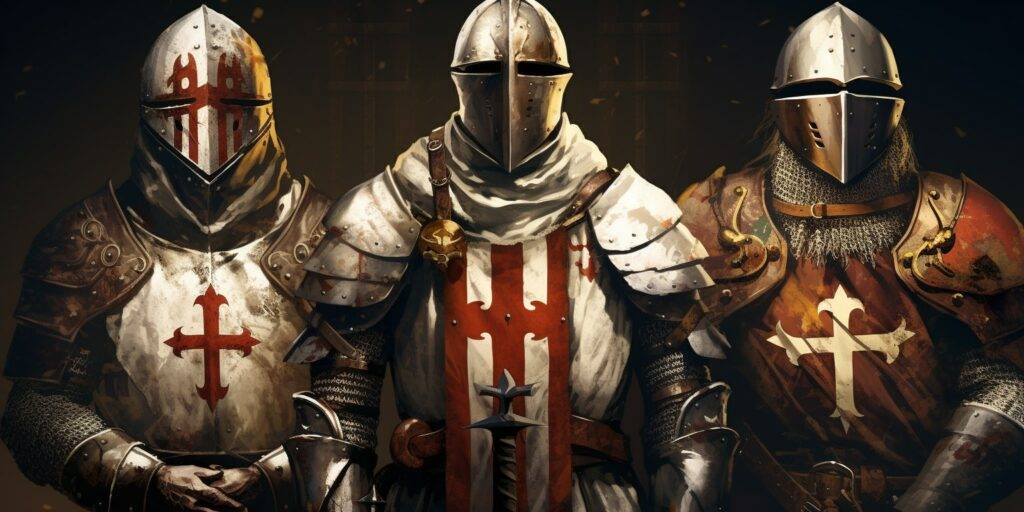Few historical organizations capture the imagination quite like the Knights Templar. Despite being officially disbanded nearly a millennium ago, these Christian warrior monks continue to feature prominently in popular culture, from video games to blockbuster films. But while conspiracy theories about their supposed modern-day influence abound, the true story of the Knights Templar is just as fascinating as any fiction.
The order's origins were surprisingly humble. In 1119 AD, two decades after the First Crusade captured Jerusalem, a French knight named Hugues de Payens gathered eight companions with a noble goal: to protect Christian pilgrims traveling in the Holy Land. With the blessing of King Baldwin II of Jerusalem, they formed a new monastic order dedicated to this task.
Initially calling themselves "The Poor Knights of the Temple of King Solomon" (later shortened to Knights Templar), the group was true to the "poor" part of their name. They relied on charity to survive, protecting pilgrims while adhering to strict vows of poverty, chastity, and obedience.
However, their reputation for bravery and dedication quickly spread throughout Christendom. Soon, the Templars became the medieval equivalent of a trendy charity, attracting donations from nobles and commoners alike. Some left land or valuables in their wills, while wealthy families sent spare sons to join the order.
The Templars' rising profile caught the attention of the Pope himself. In 1139, he issued a Papal order granting the Templars an extraordinary level of autonomy. They were exempted from taxes and placed outside local laws, answerable only to the Pope. This marked a turning point in their fortunes.
From these humble beginnings, the Knights Templar experienced a meteoric rise. At their peak, they boasted up to 20,000 members spread across Europe and the Middle East. Their military prowess evolved beyond simply protecting pilgrims; they became an elite fighting force deployed in the Crusades' fiercest battles.
Templar knights were renowned for their bravery, forbidden from retreating unless every Templar flag on the battlefield had fallen. Their fearlessness was fueled by the belief that dying in battle guaranteed immediate entry to heaven.
But the Templars' influence extended far beyond the battlefield. They leveraged their growing wealth to become one of history's first multinational corporations. They invested in real estate, buying vast tracts of land and constructing hundreds of castles and cathedrals. They owned vineyards, farms, and even entire islands (like Cyprus). The order also ventured into manufacturing and shipping, hiring blacksmiths, builders, and maintaining a substantial fleet.
Perhaps their most innovative venture was in finance. The Templars developed a system resembling modern international banking. Pilgrims could deposit valuables at a Templar house in their home country in exchange for a letter of credit, redeemable at any Templar location worldwide. This not only generated income for the order but also made pilgrims less attractive targets for bandits.
Over time, the Templars expanded their financial services to include pawning valuables, money lending, and even paying ransoms on credit. Their reputation for trustworthiness was such that even kings like Henry III of England and Philip IV of France used their services.
In less than two centuries, the Knights Templar had transformed from a small band of impoverished knights into a multinational organization wielding the wealth and influence of a small nation. However, this very success would ultimately lead to their downfall.
The loss of Jerusalem to Muslim forces in 1187 (briefly regained and lost again by 1244) raised questions about the Templars' purpose. More critically, their financial power had created powerful debtors, including King Philip IV of France.
Seizing on shifting public sentiment, Philip accused the Templars of heresy, including charges of spitting on the cross, worshipping false idols, and engaging in homosexual activities. While largely fabricated, these accusations provided a pretext for Philip to eliminate his debts and seize the Templars' vast wealth.
Through torture, Philip extracted confessions from prominent Templars, including Grand Master Jacques de Molay. Although many later recanted, the damage was done. Under pressure from Philip, the Pope ordered the arrest and trial of all Templars in Europe. By 1312, the order was officially disbanded.
Hundreds, perhaps thousands, of Templars were executed, including de Molay, who was burned at the stake in Paris. Legend has it that de Molay cursed both the Pope and King Philip as he died, and indeed, both men would be dead within a year.
While most Templars who escaped persecution joined other Catholic orders or simply retired, the organization's dramatic fall spawned countless myths and conspiracy theories that persist to this day. Many groups claim Templar heritage, though most are merely appropriating the name for its cool factor.
One legitimate modern link to the Templars exists in Portugal's Military Order of Christ. When other European monarchs were arresting Templars, King Denis of Portugal instead invited survivors to join this new order, which continues to exist over 700 years later.
The Templars' legacy lives on in other ways too. Many buildings they constructed still stand, including London's Temple district and numerous churches and castles across Europe and the Middle East.
In the end, the documented history of the Knights Templar – their rapid rise from humble protectors to a powerful multinational organization, and their equally dramatic fall – is more captivating than most of the myths surrounding them. Their story serves as a remarkable chapter in medieval history, showcasing the complex interplay of religion, politics, and finance that shaped the world we know today.


